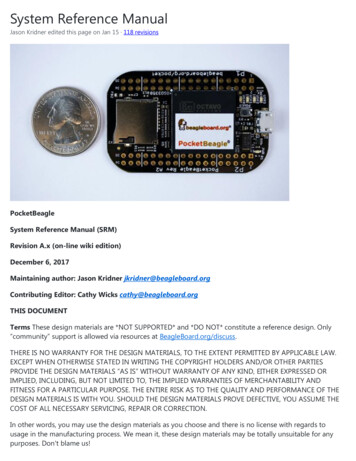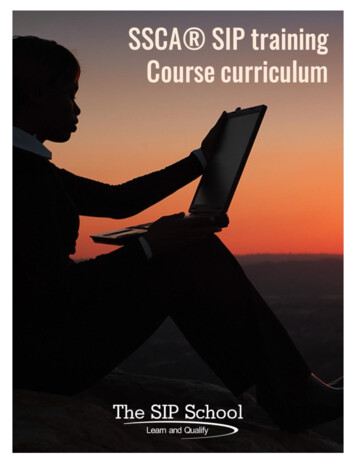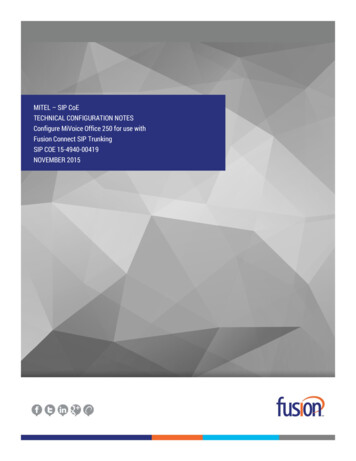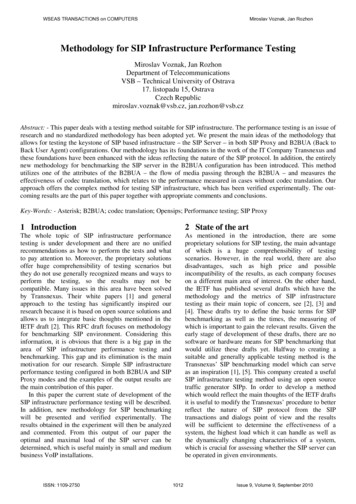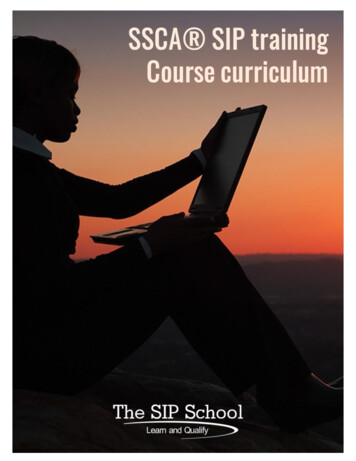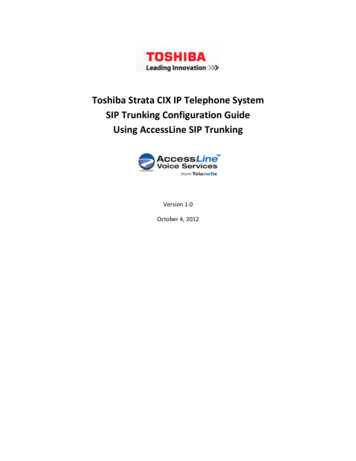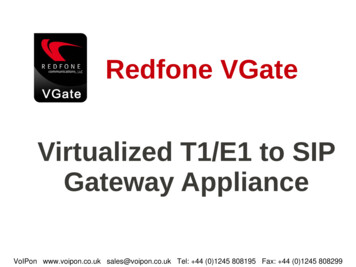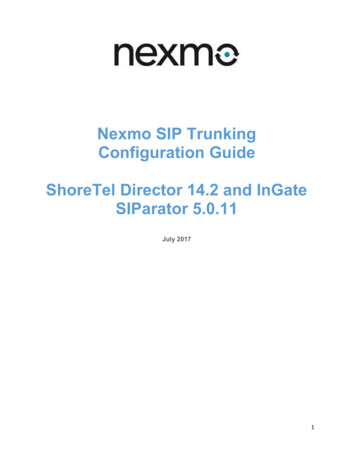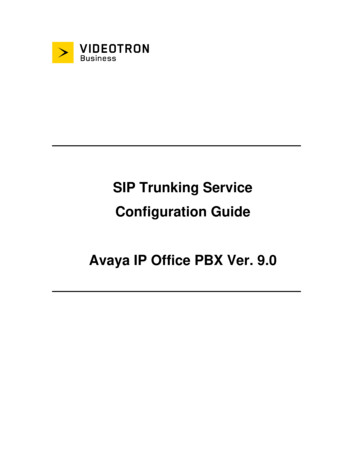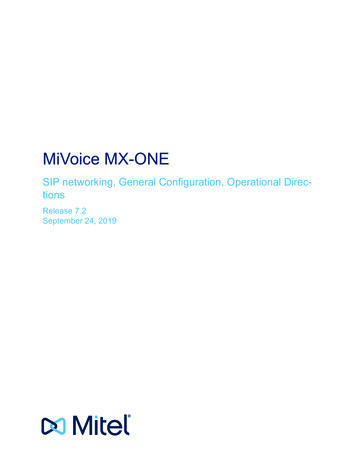
Transcription
MiVoice MX-ONESIP networking, General Configuration, Operational DirectionsRelease 7.2September 24, 2019
NoticeThe information contained in this document is believed to be accurate in all respects but is not warranted by Mitel Networks Corporation (MITEL ). The information is subject to change without notice and should not be construed in any way as a commitment by Mitel or any of its affiliates or subsidiaries. Mitel and its affiliates and subsidiaries assume no responsibility for any errorsor omissions in this document. Revisions of this document or new editions of it may be issued to incorporate such changes.Nopart of this document can be reproduced or transmitted in any form or by any means - electronic or mechanical - for any purposewithout written permission from Mitel Networks Corporation.TrademarksThe trademarks, service marks, logos and graphics (collectively “Trademarks”) appearing on Mitel's Internet sites or in its publications are registered and unregistered trademarks of Mitel Networks Corporation (MNC) or its subsidiaries (collectively "Mitel")or others. Use of the Trademarks is prohibited without the express consent from Mitel. Please contact our legal department atlegal@mitel.com for additional information. For a list of the worldwide Mitel Networks Corporation registered trademarks, pleaserefer to the website: http://www.mitel.com/trademarks. , Trademark of Mitel Networks Corporation Copyright 2019, Mitel Networks CorporationAll rights reserved163/154 31-ANF 901 14 Uen Uen PB1 2019-09-24
ContentsChapter: 1GENERAL . . . . . . . . . . . . . . . . . . . . . . . . . . . . . . . . . . . 1Introduction . . . . . . . . . . . . . . . . . . . . . . . . . . . . . . . . . . 1Glossary . . . . . . . . . . . . . . . . . . . . . . . . . . . . . . . . . . . . 1Chapter: 2Prerequisites . . . . . . . . . . . . . . . . . . . . . . . . . . . . . . . . . 2Chapter: 3Aids . . . . . . . . . . . . . . . . . . . . . . . . . . . . . . . . . . . . . . 3Chapter: 4References . . . . . . . . . . . . . . . . . . . . . . . . . . . . . . . . . . 4Chapter: 5Procedure . . . . . . . . . . . . . . . . . . . . . . . . . . . . . . . . . . 5Initiation . . . . . . . . . . . . . . . . . . . . . . . . . . . . . . . . . . . . 5Removal . . . . . . . . . . . . . . . . . . . . . . . . . . . . . . . . . . . . 5Chapter: 6Execution . . . . . . . . . . . . . . . . . . . . . . . . . . . . . . . . . . . 6Configuration of SIP-Related, General Data . . . . . . . . . . . . . . . . 6Matching Order in SIP Invite, SIP Options, etc. . . . . . . . . . . 6Considerations When Setting Up SIP Trunks . . . . . . . . . . . . 6Using TRUNK INFO . . . . . . . . . . . . . . . . . . . . . . . . . . . . . . . . . . . . . 7Using TRUNK USER . . . . . . . . . . . . . . . . . . . . . . . . . . . . . . . . . . . . . 7Using CONTACT DOMAIN . . . . . . . . . . . . . . . . . . . . . . . . . . . . . . . 7Using FROM DOMAIN . . . . . . . . . . . . . . . . . . . . . . . . . . . . . . . . . . 7Using REMOTE IP . . . . . . . . . . . . . . . . . . . . . . . . . . . . . . . . . . . . . . 7Using ALL . . . . . . . . . . . . . . . . . . . . . . . . . . . . . . . . . . . . . . . . . . . . . 8SIP Route . . . . . . . . . . . . . . . . . . . . . . . . . . . . . . . . . . . 8SIP Extension . . . . . . . . . . . . . . . . . . . . . . . . . . . . . . . . . 8Incoming SIP route Settings when WebRTC is Used in Client/Gateway . 8Chapter: 7Termination . . . . . . . . . . . . . . . . . . . . . . . . . . . . . . . . . 9163/154 31-ANF 901 14 Uen Uen C 2019-10-18
CHAPTER 1INTRODUCTIONGENERALGENERALIntroductionThe actual management of SIP routes and SIP extensions is described in the ROUTE DATA OperationalDirections and in the IP EXTENSION Operational Directions, but this document provides some generalconsiderations and prerequisites for the planning and configuration of the SIP resources.The MX-ONE is using matching of data in the incoming SIP INVITEs (and other SIP messages) to determine how a SIP message should be handled.If the information elements conflict, it is impossible to determine if the calls originate from a SIP extensionor a SIP route. Care has to be taken when planning the network regarding server/domain names andhandling of calls via boarder-gateways orSIP-aware NAT gateways.GlossaryFor a complete list of abbreviations and glossary, see the description for ACRONYMS, ABBREVIATIONSAND GLOSSARY.163/154 31-ANF 901 14 Uen Uen C 2019-10-181
CHAPTER 2PREREQUISITESPrerequisitesSIP extensions and SIP trunks are used.163/154 31-ANF 901 14 Uen Uen C 2019-10-182
CHAPTER 3AIDSAidsI/O terminal.163/154 31-ANF 901 14 Uen Uen C 2019-10-183
CHAPTER 4REFERENCESReferencesIn these operational directions, references are made to the following documents:Command Descriptions:Route Data, RO (in the Technical ReferenceGuide, MML commands)sip route and sip domain (in the TechnicalReference Guide, unix commands)Operational Directions:Route DataIP extension163/154 31-ANF 901 14 Uen Uen C 2019-10-184
CHAPTER 5INITIATIONPROCEDUREProcedureSIP configuration procedures are listed in this section.InitiationThe following work flow must be followed when initiating a SIP route/extension:1. Configuration of SIP-related, system- or domain-wide data2. Initiation of the SIP route/extension.RemovalThe following work flow must be followed when removing a SIP route/extension:1. Removal of a SIP route/extension.163/154 31-ANF 901 14 Uen Uen C 2019-10-185
CONFIGURATION OF SIP-RELATED, GENERAL DATAEXECUTIONCHAPTER 6ExecutionSIP execution information is presented in this section.Configuration of SIP-Related, General DataThe general SIP configuration details are discussed in this section.Matching Order in SIP Invite, SIP Options, etc.1.2.If a SIP INVITE is received, a check is done of the dialed number. If it matches a configured emergency number set in any configured route (-match EMERGENCY) the call will be accepted as anemergency call and will not be checked for passwords etc.If the INVITE does not have an emergency number, tests are made on other parts of the request,each route is tested according to the setting for the trunk. Each trunk will test one of:a.b.Match any string in the header information (-match TRUNK INFO).Match user part of the header information (-match TRUNK USER).3.Match host/domain part of the contact information (-match CONTACT DO- MAIN).4.Match host/domain part of the from information (-match FROM DOMAIN). e: Matching the sender’sIP address (-match REMOTE IP).Only one test type will be done per route, but the information to match may be a comma separated list.The order the tests are made is determined by the -priority parameter, and secondly by the route number,starting with the lowest number.If a match is found the call will continue as a trunk call.5. If the test for route traffic failed, the system will test if the request is matching the MX-ONE domain ofthe PBX, or own LIM’s address, set during installation, see the installation instructions INSTALLINGAND CONFIGURING MIVOICE MX-ONE or (optionally) by the sip domain command. If the “fromdomain” matches, the call will proceed as an extension call.6.A route may be programmed to accept all calls, without other tests (-match ALL).This (ALL) should only be used when testing, as it abandons all security, since the call will be admittedas trunk call.Considerations When Setting Up SIP TrunksUsing different domain information is important, and planning the DNS and IP network structure is key tosolving how to differentiate extensions from trunks and different trunks from each other.Modification of SIP information in border-gateways might be a method to get the information needed whenhandling both trunks and extensions connected from public Internet, or VPN tunnels.The sub-sections below refer to parameters in the sip route command.163/154 31-ANF 901 14 Uen Uen C 2019-10-186
CHAPTER 6CONFIGURATION OF SIP-RELATED, GENERAL DATAEXECUTIONUsing TRUNK INFONormally this is used together with optional parameters like tgrp and trunk-context sent from the remoteside.This would also require that the from information sent from local side is configured correctly, as this is thebasis for re-invite information from remote side.Normally trunk-context is used to transfer TypeOfNumber information, by matching trunk-context tocontextXX settings. Matching is normally used to identify the route to tgrp string.Example:-uristring0 "sip:?;tgrp mitel;trunk-context canada.mitel.com@ca.mitel.com"-uristring1 "sip: ?;tgrp mitel;trunk-context public.mitel.com@ca.mitel.com"-fromstring0 "sip:?;tgrp mitel;trunk-context sweden.mitel.com@se.mitel.com"-fromstring1 "sip: ?;tgrp mitel;trunk-context public.mitel.com@se.mitel.com"-accept TRUNK INFO -match "tgrp mitel"-contexta0 "trunk-context canada.mitel.com"-contexta1 "trunk-context public.mitel.com"Using TRUNK USERThis setting will match the user part of the INVITE header.Used normally when the invite URI is sent to a common user, and the “to” field is used for the callednumber. (TrunkProfile:XXX:bNumberSource to header)Example:-accept TRUNK USER -match " 4681230000"Using CONTACT DOMAINThis setting will match the information in the server part of the contact header. Be sure this information isunique, and only sent from the remote switch.Example:-accept CONTACT DOMAIN -match "ca.mitel.com"Using FROM DOMAINThis setting will match the information in the server part of the from header. Be sure this information isunique, and only sent from the remote switch.Example:-accept FROM DOMAIN -match "ca.mitel.com"Using REMOTE IPMatching remote IP address from sender requires that the sender is unique for this route.If for instance the proxy/gateway is also used for externally connected extensions, there will be problemsto as you will catch also those telephones as trunk users.163/154 31-ANF 901 14 Uen Uen C 2019-10-187
CHAPTER 6SIP ROUTEEXECUTIONExample:-accept REMOTE IP -match "1.2.3.4"Using ALLThis is purely intended for testing and should never be used in production. Example:-accept ALLSIP RouteSee the Operational Directions ROUTE DATA, section on SIP route, and the command description forsip route.SIP ExtensionSee the Operational Directions IP EXTENSION.Incoming SIP route Settings when WebRTC is Used inClient/GatewayWhen setting up incoming SIP routes (or trunks) you may limit access to the routes (or trunk) by usingincoming firewalls with TLS or tunneling. You can, and must for security reasons, set up rules for authentication on the trunk interface by using digest credentials (controlled by "401 Unauthorized" or "407 ProxyAuthentication Required"). See Operational Directions Route Data for details.163/154 31-ANF 901 14 Uen Uen C 2019-10-188
CHAPTER 7TERMINATIONTerminationInform the system or IT department manager if any alteration is made.If any system data have been changed, a data backup operation must be performed.163/154 31-ANF 901 14 Uen Uen C 2019-10-189
mitel.com Copyright 2019, Mitel Networks Corporation. All Rights Reserved. The Mitel word and logo are trademarks of Mitel NetworksCorporation, including itself and subsidiaries and authorized entities. Any reference to third party trademarks are for reference only and Mitelmakes no representation of ownership of these marks.
The following work flow must be followed when initiating a SIP route/extension: 1. Configuration of SIP-related, system- or domain-wide data 2. Initiation of the SIP route/extension. Removal The following work flow must be followed when removing a SIP route/extension: 1. Removal of a SIP route/extension. 163/154 31-ANF 901 14 Uen Uen C 2019-10-18
